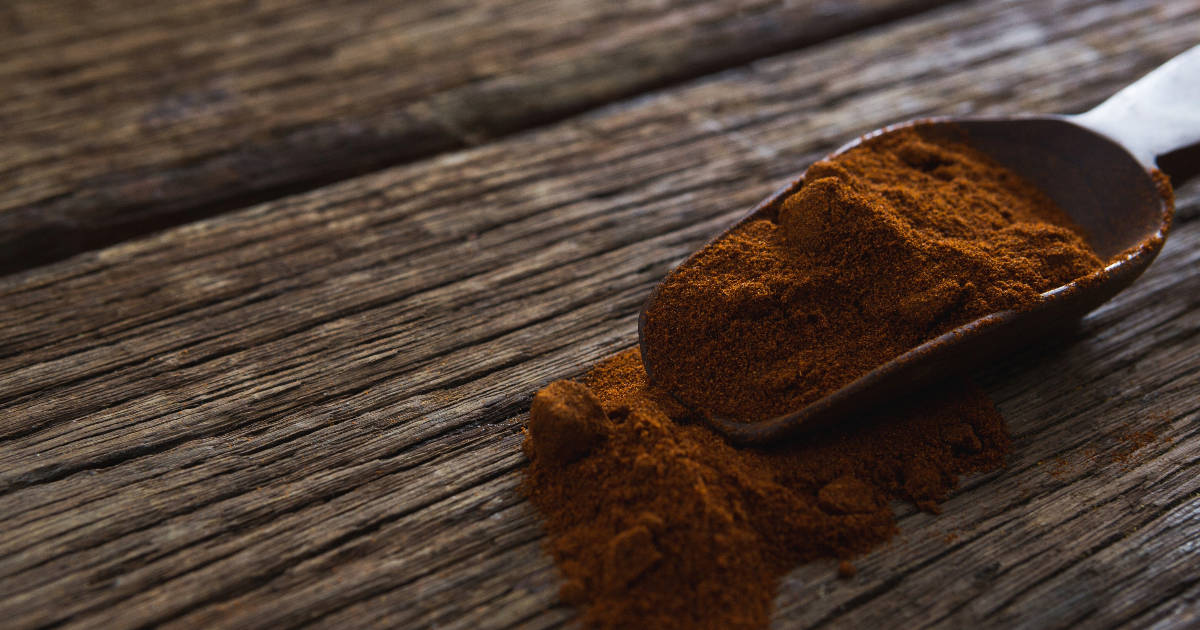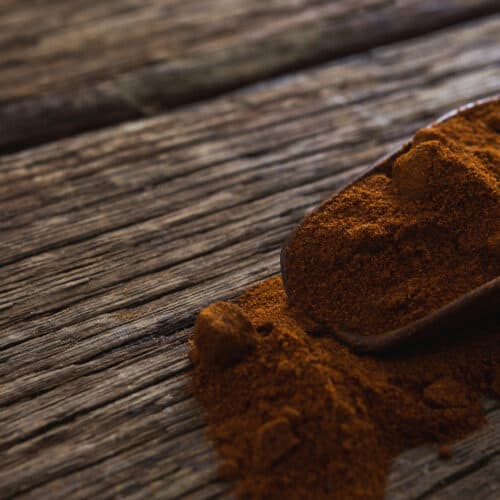Rasam powder, also known as rasam podi, is an aromatic and flavorful South Indian spice blend that forms the base for making rasam.

Rasam powder is essentially a mixture of ground lentils, spices, and herbs. It is what imparts that signature tangy, spicy and incredible depth of flavors to the rasam.
While fresh tomatoes, tamarind juice, garlic, curry leaves etc. also play their part in enhancing the rasam's taste, it's the rasam podi that makes it robust, flavorful and aromatic.
Without this spice blend added, you simply wouldn't get an authentic tasting rasam.
How to Make Rasam Powder at Home

Rasam Powder Recipe
Ingredients
- 1 cup coriander seeds
- 1/4 cup toor dal
- 1/4 cup chana dal
- 2 tbsp cumin seeds
- 1-2 tsp black peppercorns
- 4-6 dried red chilies
- 1/4-1/2 tbsp fenugreek seeds (optional)
- Handful of curry leaves
- 1/2 tsp asafoetida (optional)
Instructions
- Dry Roast the lentils - In a pan, dry roast the toor dal and chana dal separately till aromatic and light golden. Set aside.
- Roast spices - Roast coriander seeds, red chilies, black peppercorns, cumin seeds individually till fragrant. Roast curry leaves last.
- Let cool - Transfer everything to a plate and let cool completely.
- Grind - Grind the roasted ingredients to a fine powder in mixer. Store in an airtight container.
And your homemade rasam powder is ready!
For a serving of 4, use about 1-2 tbsp of this powder when making rasam.
Key Takeaway: Making rasam powder involves roasting whole spices individually, cooling completely, and grinding to a fine powder. About 1-2 tbsp is used per serving.
Tips for the Best Homemade Rasam Powder
- Dry roast on low flame to prevent burning of spices. Roast individually for optimal flavor.
- Let the mixture cool fully before grinding for a aromatic powder.
- Store in an air-tight container to retain freshness up to 6 months. Refrigerate for longer shelf life.
- Adjust chili quantity based on spice levels preferred. Less is better for kids.
- Use a powerful mixer like food processor for finer grinding. Sieve if needed.
- Make small batches as needed since homemade tastes far superior to store-bought powders.
Now that you know how to make flavorful rasam powder at home, let's understand what rasam actually is.
All About the South Indian Rasam:
Rasam is essentially a thin lentil-based soup that has a slightly tangy and spicy taste. Tomatoes, garlic, curry leaves and other ingredients are used for tempering this broth like dish.
But the main element that lends it that unique zesty taste is the rasam powder. Tamarind is also added which gives it a nice sourness.
This peppery hot soup doesn't have a thick consistency and tastes like a flavorful water broth enriched with the goodness of herbs and spices. Both the aroma and taste is incredible!
Rasam is had a companion with rice or even enjoyed plain as a light digestive drink. It is quite versatile and every state in South India has its own variation.
Different Types of Rasam Recipes
There are many popular variants of rasam made across South Indian households:
- Tomato Rasam: Made using tomatoes and rasam powder. Thick and tangy taste.
- Lemon Rasam: Prepared with lemon juice and tempered with ghee and curry leaves.
- Pepper Rasam: Features black pepper prominently for a spicy flavor.
- Garlic Rasam: Uses garlic paste as the main ingredient. Robust taste.
- Tamarind Rasam: Made with tamarind pulp or juice to give a sweet-tangy taste.
- Mysore Rasam: Features asafoetida tempering for a pungent flavor.
And the list really goes on with so many innovative rasam recipes. But they all have one common element - aromatic homemade rasam powder!
Key Takeaway: Rasam is a thin, tangy and peppery lentil-based broth from South India that features aromatic homemade rasam powder as a key ingredient.
Serving & Storing Suggestions for Rasam
Here are some popular ways that rasam is enjoyed in South Indian homes:
- As a standalone soup
- Along with rice - known as rasam rice
- With idli, dosa, vada etc. for meals
- As a healthy digestive drink
- Topped with chopped onions, curry leaves etc.
- Spiced up with a tempering of mustard, curry leaves etc.
Playing around with the toppings and tempering can give a wonderful twist to this simple rasam soup.
Since homemade rasam powder tastes best when fresh, follow these tips to store correctly:
- Store in clean, dry glass/steel containers
- Put in small batches to retain freshness
- Seal tightly & store in cool, dark place
- Refrigerate for upto 1 year
- Avoid moisture getting in
- Use clean & dry spoon always
Proper storing is key for the rasam powder to retain its beautiful aroma and flavors over months.
Key Takeaway: Rasam powder stays fresh upto 1 year when stored correctly in air-tight containers in fridge. Small batches are best.
FAQs
Does rasam powder contain garlic?
No, garlic is usually not added in basic rasam powder recipe. However, some recipes do include it.
Can we use rasam powder for curries?
Yes, you can add rasam powder to vegetable and lentil curries for a tangy and robust taste. Start with 1 tsp per serving.
Is rasam powder same as sambar powder?
No. While they use some common ingredients, the proportion varies. Rasam powder tastes tangier while sambar powder is hotter.
Does rasam powder require refrigeration?
You can store rasam powder at room temperature for upto 6 months in air-tight containers. For longer shelf life of ~1 year, refrigerate.
How much rasam powder per serving?
For a serving size of 4-5 people, use about 1-2 tbsp of homemade rasam powder in rasam recipes.
Conclusion
Rasam powder is what makes a simple rasam transform into an explosion of complex flavors. By learning to make it easily at home, you can treat yourself to soul-soothing bowls of aromatic rasam whenever cravings strike!
Adjust the level of spices as per taste and spice tolerance. Play around with tempering recipes and sides. But do keep whipping up batches of freshly ground homemade rasam masala.
Because as South Indians would agree, no readymade powder can ever replace the taste of homestyle rasam podi made from scratch!
Resources:
- Swasthi's Recipes: This page provides a recipe for making fresh aromatic Rasam Powder with roasted lentils, spices, and herbs. It also offers step-by-step instructions and tips for the recipe.
- Veg Recipes of India: This website offers a homemade Rasam Powder recipe, explaining the essential ingredients and the process of making this quintessential aromatic spice blend used in classic South Indian Rasam.
- YouTube: This video demonstrates how to make Rasam using Eastern Rasam Powder, providing a visual guide to preparing Rasam using this specific brand of Rasam Powder.
- NatureMills India: This site offers NatureMills Rasam Powder, made from an authentic homestyle recipe using a blend of Indian spices. It provides the option to purchase the product.
- Shanthi Krishnakumar's Cook Book: This blog page discusses Rasam Powder and its use in a recipe, although it seems to have a small problem with the link to the Rasam Powder.

